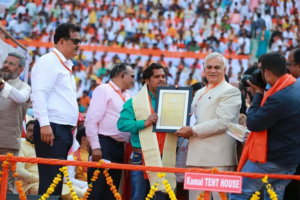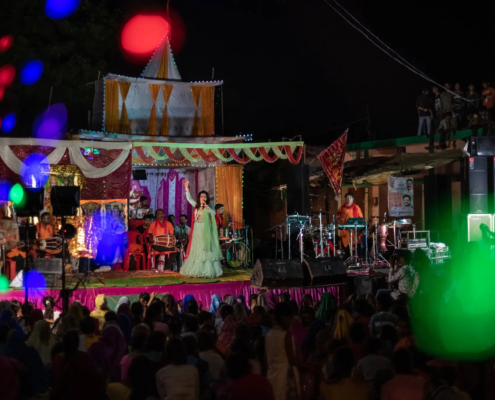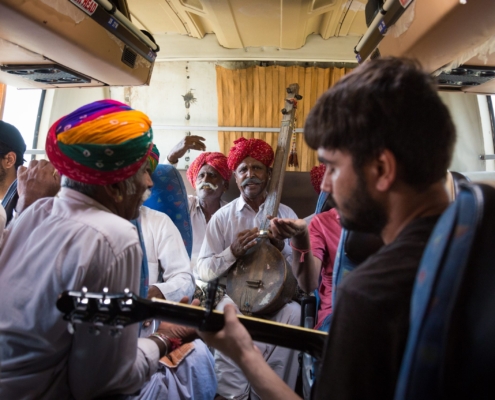In this interview, ISH fellow Mukesh Kulriya sits down with Akanksha Saxena, an award-winning digital and TV journalist at Deutsche Welle who recently completed a documentary on the spread of hateful rhetoric through Indian pop music. They discuss the troubling trend of Hindutva pop, or H-pop, a genre that combines high-tempo dance beats with often incendiary Hindu nationalist messages that mirror the ideology of India’s current ruling party, the Bharatiya Janata Party (BJP), which has been in power since 2014. Of particular concern is the effect these songs potentially have on children, who might absorb these radicalizing messages unconsciously, as well as the genre’s potential to encourage violence against the country’s Muslim minority.

Supporters of Bharatiya Janata Party cheer at an election rally of Narendra Modi in Amethi Lok Sabha constituency in Uttar Pradesh (Photo credit: Wikimedia Commons)
Mukesh: Welcome, Akanksha. We are going to talk
about music and hate today. Can music counter hate in society? Since you covered stories around Hindutva pop,[1] could you share your insights?
Akanksha: Thanks, Mukesh, for having me. I can’t say I am an expert in the field of music. But I have covered a story on the intersections of music vis-à-vis society vis-à-vis hate and hate speech. So, one of the stories that I covered was on the Hindutva pop phenomenon, India: Anti-Muslim hate music.
I noticed that in large parts of the Hindi belt, there is a pop culture emerging. [T]hey are singing songs which are very derogatory [to] the minority community, especially Muslims in India. Music… is something that has always been part of the fabric of India. You hear music from the day you are born to the day you die. And it’s everywhere that you go. Whether you take an auto rickshaw in Delhi, for instance, there will be music blaring out of the speaker there. Or you are on a bus. Or you are even like you are visiting someone. There will be… different kinds of music.
Particularly if you talk about hate, music plays a big, big role. Because it’s not a direct medium for any kind of propagation of an idea. It’s a very indirect medium. It’s something that can be laced with lyrics. It can be laced with beats. It can get into the psychology of a young person. One [interviewee]…who consumes Hindutva pop regularly, did not even know initially about its lyrics. He believed them to be soundtracks of religion, talking about a Hindu religious deity. But when I asked [him] to go into the detail[s] of the lyrics and what it is that they talk about… that’s when this person also felt that this was talking about a certain agenda, a certain ideology, which was hateful towards a minority community. And he was surprised that, for the first time, he noticed it.
[Music is ]not a very active medium, it’s a passive medium. But it does enter your psychology, and it stays there… [O]ne of the big roles that music plays in society is that it is part and parcel of your everyday life, it’s always constantly there in the [background]. I also went to interview two of the very prominent Hindutva pop singers in the state of Uttar Pradesh. I wanted to understand the kind of outreach they have and where they sing. Do they sing in religious processions? Where are they? They are writing very hateful lyrics, going on with the ideology of the present disposition. But they’re getting…very young children, three, four, five-year-olds, dancing to these numbers. Like, the music that we danced to when we were young, that has stayed with us in our adulthood and may carry forward to our old age. So that is a passive impact of music that stays with you for life, for a lifetime.
And I was very surprised that this kind of soundtrack is reaching the nook[s] and corner[s] of India. People come to these religious processions as a normal neighborhood gathering. But when these singers come and raise slogans through their music of very dangerous ideological standpoints, annihilating a community, [it] stays with people. And I think that kind of soundtrack is very dangerous for India.

Well known H-pop artist Prem Krishnavanshi receiving an Uttar Pradesh state award during Adityanath’s oath-taking ceremony earlier this year, in Lucknow. (Photo credit: Prem Krishnavanshi via Al Jazeera)
Mukesh: [Y]ou said something very interesting: music is in the fabric of India. When hate masquerades as music, when the lyrics and the beats come together, lyrics take a backseat in a certain sense, and beats take over because this is very high-beat music. [Often] you know the connotations of words but don’t exactly know the words. So there is a very interesting transition happening. What’s your take on this? How will we be able to look at music in a very positive sense that a lot of people still would like to think that music is something divine, soothing, and it brings people together?
Akanksha: See, elementally, if you talk about beats…the lyrics [take] a backseat. The person had to remember what was being said. The music was being made on auto-tuning. And then some beats are mixed with it. It’s happening in very small studios spread all across North India. I went to one of them, and they had an array of things. They sing Bhojpuri songs;[2] they sing songs about Holi,[3] they sing songs about cultural festivals, or even Eid.[4] So, there’s a mix of things. So, when you go into studios, you don’t necessarily think they are the agents of Hindutva-pop.
But what you understand when they’re mixing the tunes, when they’re making the music, it has the power to capture the minds of really young people, mostly not just because of lyrics, but also because of the beats, or how they are being composed, or how they are being mixed. So I feel that a similar counter-strategy can also take place among more pluralistic people, singers who are more pluralistic, to use similar kinds of vehicles to propagate the idea of togetherness…. We’ve seen a lot of this happening in folk songs. It is a very populist pop genre of songs. I have not heard very many pop songs that talk about pluralism.
But the Hindutva pop songs, with the DJ[5]… This is called a DJ set song in Uttar Pradesh. Like, the DJ is going to be playing. These beats will play. And the procession will take place. And if they go through a Muslim locality or in front of the masjid [i.e., a mosque], they will blare it more. So, that leads to another set of issues like inciting violence.
But if something like this happens in the consciousness of people or singers, I feel like there could be a counter-strategy, similar to what is being employed by the far-right elements, into a more pluralistic understanding with the same beats. What this genre does…is different from a folk genre or a classical singing genre. It’s a very populist medium. It connects people. People dance on it. But I have not seen a very pluralistic depiction of any kind of song like this that exists.[6]
And if that happens, I think there is a space for something like this also. If you want to reach the populist understanding and change, as I said, through a passive way, if you want to change, this could also take place, and somebody picks the mantle.
Mukesh: Thank you. I think that’s very enlightening. You worked in India, and so you consumed this culture, you’ve been brought up in India. Now you work abroad as a journalist. I mean, your identity as a journalist is important, but you’re also seen as “from India.” And India, at the present moment, it’s one of the big cultural industries. K-pop is there, but the Indian culture industry is also very popular, especially in the Global South and throughout the Indian diaspora. What sense do you have of the consumption of Indian culture outside of India? Is it pluralistic, or are they more drawn to these new age, Hindutva pop songs? Or are they more into Bollywood[7] songs?
Akanksha: [P]rimarily… and I can’t say as a scholar of this subject, but I think broadly it is Bollywood if you talk about Germany or Europe. I’ve been to places where people have stopped me and sung a Bollywood number. It’s such a cultural phenomenon. In Istanbul, for instance, I was stopped, and people would sing Raj Kapoor songs, or they would stop, and they would sing a song from Aamir Khan’s films because they are a big, big draw there. I am not very aware of whether there is a Hindutva pop or a similar phenomenon. People like that or not. I’m not sure it has reached there yet. It’s not popular, certainly. They are still being ruled by Bollywood, more or less. So, it’s mostly Bollywood songs.
Mukesh: So it’s a phenomenon within India?
Akanksha: Yes, I think… I feel this is also a very recent phenomenon. For example, people who talk to me about Bollywood are still talking about films that were released 15-20 years ago. I don’t know in 10 years or 15 years if [old Bollywood movies] will remain the [most popular Indian cultural export] or if the newly emerging ones, like Hindutva pop, will have a share in it. Whether or not it’ll reach there. I’m not sure about it yet. But yes, Bollywood is what people consume, and they don’t consume so much of recent cinema. I’m not talking about [the Indian] diaspora. I’m talking about people who consume Bollywood films as an ‘interest’ or… out of curiosity. They’re still looking at Bollywood from 15 or 20 years ago. They don’t know the new songs, for example. They still know Kuchh Kuchh Hota Hai[8] or the Karan Johar[9] genre of films. But no. I would think that Hindutva pop songs are still pretty much contained within the boundaries of the country. It has not yet reached Europe. Maybe among the diaspora, but I’m not sure yet.
Mukesh: It may be an underground scene there.
Akanksha: I’m not sure about it again because I’ve never heard anybody listen to those songs. I mean, if they play at any Indian gathering, I’m not aware of that. I have largely not seen it. Also, the [Indians living in the] diaspora that I have spoken to mostly are white-collar, you know, engineering students from south of India. Now, what kind of music they are consuming, I’m not very sure.
Mukesh: Now if you look at the brighter side of music, if we can use that word, I spoke about the Rajasthan Kabir Yatra.[10] Even if you would not participate in it, just as an idea like, okay, we are using music to counter hate. What [bells] does it ring in your mind?

H-Pop star Laxmi Dubey performing last month in the town of Tumgaon, near Raipur, India. (Photo credit: Rebecca Conway for The New York Times)
Akanksha: I think it’s a very positive step. I think it is what [is needed now]. I feel that, largely in music also, there is a division of class. If I can say. A lot of folk music is understood, loved, you know, enjoyed by a lot of rural folks. I mean, of course, you hear a lot of folk music from the people who are connoisseurs of that music. People are listening to it in Delhi, but largely, people who love folk art live in the interior of the country where [polarization is] becoming more and more prominent. So, the division of society…is everywhere. It’s getting polarized. But if you reach the affected people through initiatives like this, the animosity could be countered even in cities, where these traditions don’t exist. But when it comes to villages and communities that have lived together for centuries, and when they get divided based on any kind of ideology, then music is, I think, one of the best medicines… not just also [to heal]this division, but also as a preventative measure as well. I feel it can reach far and wide. If there’s a pluralistic understanding of music, if folk art or folk music or things like Rajasthan Kabir Yatra can foster that kind of brotherhood, that idea of pluralistic India through their songs, through their music, I think people understand it better than verbal words.
I think it’s so much part of our lives that a message gets across faster and broader through music than through verbal messages. It’s a great idea…. It probably has far reaching consequences if this is done regularly. If… the aim, especially in communally hit districts or villages, [is] to foster some kind of understanding… [F]olk [music] has a very easy understanding among people [throughout the world]. It is more receptive. So, people understand that this is their language. This is not foreign. You know, like Bollywood, still largely in rural areas, it’s happening somewhere else. It’s not our music. If the music of the local language, the local artists, talk[s] about communal harmony, then it should… have a greater impact.
Mukesh: I think, last question, I think it’s a broader question that you have seen conflict, you have covered conflict, and you know, conflict breaks communities. What is left behind is this broken community. And at the end of the day, everyone will leave. Those communities have to either live together or some of them have to leave that place forever. It’s not just a law-and-order problem, right? It’s much more than that. I mean, if some people are not killing each other, it doesn’t mean they are happy together or they are coexisting. What is your take on police using music… to counter hate?
Akanksha: See…police work [is] an [institution] … [and can take different] institutional forms in different states. You said about conflict. So, I’ll just briefly touch upon it. In India-administered Kashmir, there are problems not just within communities or within homes, there is a general sense of distrust [between] people…. I was talking to somebody here who doesn’t trust [their] brother living under the same roof. You know, so this is what conflict does to you. And communal riots also foster this kind of distrust among people. Violence sows the seed of distrust and disrespect. People just want to be confined to their own families; their identity becomes the most prominent thing.

Folk artists perform during the Rajasthan Kabir Yatra music festival. (Photo credit: Rajasthan Kabir Yatra)
I have always just seen the police’s role so far in the conflict as being the enforcers of law and order…. But this is an interesting role that you’re talking about because I have not seen the police being an active part of it.
I have also seen, for example, in Madhya Pradesh, people doing sensitization among communities, such as women police officers. They do gender sensitization among schools for young boys to sensitize about gender roles. But I’ve not heard of police taking initiatives for communal harmony. Sometimes the police are seen as an extension of the government. Especially practically if you talk about how the police [enforce laws] you see that [they are] an extension of the arm of the government. There are accusations that the government is fostering distrust and mistrust between people, and communal violence is not handled with care.
So, police taking a role like that not just speaks volumes about their sensitivity to communal harmony. Also, I feel they should add it perhaps in the way they function because if they’re fostering any kind of brotherhood organizing programs like this, it will go a long way in how the governance is done, how the policing is done, how law and order and police are seen… as part of the society. Because in a lot of places, people are scared of the police. Yeah, they just stay away from the police. People don’t even go to record testimonies at the police station. They think that the police are not going to help them.
So, from the point of view of approachability and cooperation, people will start looking at police as somebody they can go to talk to, and I think it would just break the barriers as well. I believe music… can do that, and if police or the authorities are taking this approach to handle a communal violence situation…I think it’s a long-term investment for them.
Mukesh: Thank you, Akanksha, for your time and insights.
Akanksha: Thank you, Mukesh, for having me over to speak on this.
Akanksha Saxena is an award-winning digital and TV journalist focusing on political, social, and environmental issues affecting South Asian societies, including the dangers posed by growing right-wing nationalism. She has won several awards, including the Laadli Media Award in 2022; a gold medal at the New York Festivals in 2022; and a silver medal at the World Media Festivals in 2023. Before joining DW, Akanksha worked with media outlets including TRT World and the BBC. (Courtesy of DW News)
Mukesh Kulriya is a graduate student in Ethnomusicology, UCLA, and an ISH fellow for 2023-24. This interview is part of his ISH project, “Countering Religious Hate: Music as Mitigation Strategy.”
India: Anti-Muslim hate music | DW Documentary
“Bangladesh Me Hindu Mare Ja Rahe” by Prem Krishnavanshi
“Modi Ka Abhinandan” by Laxmi Dubey
[1] Hindutva is a Hindu ethno-nationalist ideology that seeks to assert Hindu supremacy over India. First articulated by V.D. Savarkar in 1922, the ideology has persisted in certain segments of Indian culture throughout the past century, and has now been inherited by the current ruling party in India, the Bharatiya Janata Party (BJP). As it stands, both the government and the media are to some extent complicit in the perpetuation of Hindutva ideology in Indian culture, politics, and daily life, often using many popular cultural forms like pop music to indoctrinate followers and normalize hatred.
[2] Language native to the Bhojpur-Purvanchal region of India and parts of Nepal, which has a particularly vibrant music industry.
[3] Holi is a Hindu festival of Spring, which traditionally honors the eternal and divine love of the deities Radha and Krishna, although it holds various meanings in various regions. Celebrations often include singing and dancing, as well as festival-goers dousing each other with brightly colored powders. Unfortunately, recent Holi festivals have also coincided with increased reports of anti-Muslim hate crimes and harassment, particularly against women, leading Indian minorities to fear the event.
[4] Eid can refer to one of several annual Muslim festivals. The most important and widely celebrated of these are Eid al-Fitr, which marks the end of the holy month of Ramadan, and Eid al-Adha, which is celebrated in the twelfth month of the Islamic calendar with prayers, charitable giving, and the ritual sacrifice of an animal.
[5] Here “DJ” refers to a loud music system mounted on a vehicle. It is part of celebration in private such as wedding processions and public such as religious, political and cultural events. Such events and processions are central to the phenomenon of H-Pop.
[6] In this specific context, “populist” describes the propagation of majoritarian ethno-nationalism through various forms, here particularly through music, while “pluralistic” refers to art and music that convey a more inclusive and representative nationalism or social formation.
[7] “Bollywood” is the Hindi-language film industry based in Mumbai, India, renowned for its vibrant musicals, diverse storytelling, and global influence.
[8] A 1998 Bollywood romantic drama that intertwines themes of friendship, love, and destiny, which remains very popular both within India and in the diaspora
[9] Director of Kuch Kuch Hota Hai, Karan Johar is a prominent Indian filmmaker, producer, and television personality known for his iconic Bollywood films and influential role in shaping contemporary Indian cinema.
[10] Rajasthan Kabir Yatra (RKY) is an annual devotional music festival in Rajasthan. The Rajasthan police department collaborated with RKY to counter religious hate through music. For more information, see: https://www.rajasthankabiryatra.org/

